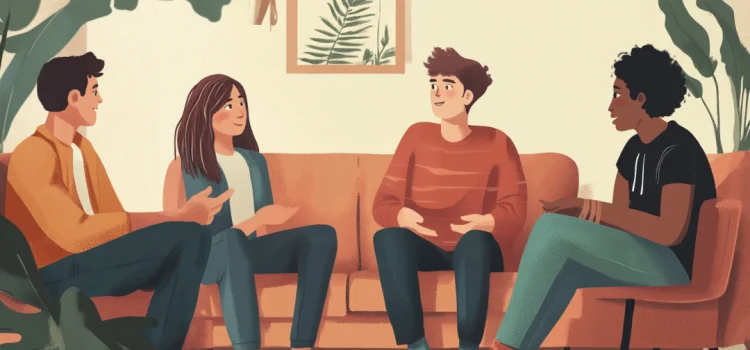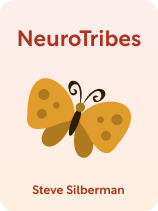

This article is an excerpt from the Shortform book guide to "NeuroTribes" by Steve Silberman. Shortform has the world's best summaries and analyses of books you should be reading.
Like this article? Sign up for a free trial here.
Why can social interactions be difficult for those with autism? Why do autistic children gravitate toward adults? What is echolalia?
For people with autism, communication and social interaction may be a struggle. This is because autistic people often struggle with eye contact, making connections, picking up on sarcasm, and more.
Keep reading to understand more about why social interaction and communication are difficult for those with ASD.
Social Interaction and Communication
In his book NeuroTribes, Steve Silberman touches on two specific ways in which autistic people may struggle with social interactions: difficulty following social norms and difficulty communicating with others. Here’s why, for those with autism, communication isn’t so straightforward.
Difficulty Following Social Norms
According to Silberman, autistic people often struggle with different aspects of social interaction, which can lead to isolation, alienation by their peers, or avoidance of social interaction. Silberman describes some specific ways autistic people struggle to interact with others.
First, they may have difficulty making eye contact—a struggle also known as gaze aversion. (Shortform note: Research suggests that autistic people have trouble making eye contact because it’s overstimulating to their brains. Studies indicate that when autistic individuals make eye contact, they experience more activity in the subcortical brain region compared to allistic individuals. Experts theorize that this oversensitivity leads autistic people to avoid eye contact as a way of lowering their arousal levels.)
Second, they may have trouble connecting with their peers, so autistic children often gravitate toward adults rather than other children. (Shortform note: Research shows that autistic children are significantly more likely to be bullied than their allistic peers. This may be the result of traits like impaired communication skills and impulsive behaviors, which can make it more difficult for them to form relationships with other children. Experts suggest educating children about neurodiversity could help protect autistic people from mistreatment.)
Third, they often have solitary tendencies and feel less inclined to participate in social activities, but they also have rich internal lives that keep them entertained and engaged.
(Shortform note: Some researchers hypothesize that autistic people are less motivated to participate in social activities because their brains receive less reward from social interaction compared to allistic people. Some autistic experts also argue that autistic people get more of a reward from spending time in their inner worlds and engaging with their special interests (which we’ll discuss more later in the guide), so they have less need for interaction than allistic people.)
Difficulty Communicating
Silberman also explains that autistic people can struggle with communicating—particularly with expressing their thoughts, feelings, and needs. (Shortform note: Research suggests that autistic people can actually communicate with other autistic people just as effectively as allistic people can communicate with other allistic people. This suggests the communication challenges autistic people often experience aren’t necessarily the result of autism itself, but rather the differences in communication style between autistic and allistic people.)
Silberman describes several differences in communication that many autistic people experience.
First, they may communicate through echolalia, or the practice of repeating things they’ve heard from others. This can include repeating words or phrases verbatim without adapting them for context. For example, an autistic child who wants a snack may ask for it by saying, “Do you want a cookie?” rather than, “I want a cookie.”
Second, they may struggle to notice and/or convey irony or sarcasm, which can lead to the misconception that autistic people can’t understand irony or humor. This may be somewhat related to literal thinking, which we’ll describe in greater detail later.
(Shortform note: Some argue that autistic people’s differences in humor are due less to trouble understanding humor and more to a tendency to enjoy different types of humor. For example, they may prefer dry humor and satire to sarcasm and slapstick humor. They may also be drawn more to nonsense humor or hyperbolic humor.)
| Types and Purposes of Echolalia Echolalia is a standard aspect of language development that all children go through. However, around age three, most children move past using echolalia to communicate, but autistic people may continue to engage in echolalia as adults. Echolalia can take different forms and have different uses. Autistic people may use interactive echolalia to communicate their wants or needs to others—recall asking, “Do you want a cookie?” to express “I want a cookie.” They may use non-interactive echolalia for a number of reasons, such as scripting or rehearsing interactions in advance, repeating what they plan to say until they feel more comfortable with it. In addition, autistic people sometimes use non-interactive echolalia to walk themselves through a situation or task, repeating instructions they’ve heard until they’ve completed the activity. For example, an autistic person may direct themself through the steps of doing their laundry by saying, “Gather up all the clothes, then put them in the washer, then add detergent, then start the washer,” and so on. Autistic people may also use non-interactive echolalia simply as a self-stimulating behavior (which we’ll discuss in the next section). This could include singing a song, repeating lines from shows and movies, or saying a familiar word or phrase over and over. |

———End of Preview———
Like what you just read? Read the rest of the world's best book summary and analysis of Steve Silberman's "NeuroTribes" at Shortform.
Here's what you'll find in our full NeuroTribes summary:
- The truth behind the common misconceptions about autism
- How society’s perception of autism has evolved since the 1930s
- The most effective treatments for autism spectrum disorder






